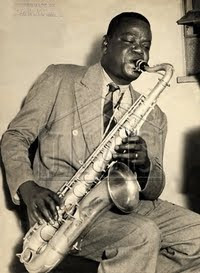Regional do Canhoto
 The evolution of choro into a musical genre as we know it today owes a lot to the 1930s and 1940s house bands of the Brazilian national and regional radio networks, the various Conjuntos Regionais, that helped shaping and spreading the concept of the genre through countless live broadcasts and recordings of popular music of the time, including choro. Some of the Conjuntos Regionais raised to national fame, one of them being the Regional of flutist Benedito Lacerda that had Pixinguinha as a member and co-leader for some time during the 1940s, now famous in the story of choro for the recordings made for Victor 1946-1950 featuring Lacerda as soloist on flute and Pixinguinha providing exceptional accompaniment on saxophone besides being the composer and arranger of several immortal pieces recorded by this group.
The evolution of choro into a musical genre as we know it today owes a lot to the 1930s and 1940s house bands of the Brazilian national and regional radio networks, the various Conjuntos Regionais, that helped shaping and spreading the concept of the genre through countless live broadcasts and recordings of popular music of the time, including choro. Some of the Conjuntos Regionais raised to national fame, one of them being the Regional of flutist Benedito Lacerda that had Pixinguinha as a member and co-leader for some time during the 1940s, now famous in the story of choro for the recordings made for Victor 1946-1950 featuring Lacerda as soloist on flute and Pixinguinha providing exceptional accompaniment on saxophone besides being the composer and arranger of several immortal pieces recorded by this group. However, when Lacerda left the group around 1950 after the successfull co-work with Pixinguinha, the leadership was taken over by the group's left-handed cavaquinho player, Waldiro Frederico Tramontano known as Canhoto (1908-1986). The group began their professional activities in 1951, accompanying great artists at Rádio Mayrink Veiga and recording for Victor. The members of Regional do Canhoto included, besides the leader on cavaquinho: violonistas Dino and Meira, flutist Altamiro Carrilho, accordionist Orlando Silveira, and pandeirista Gilson de Freitas (see picture above). The Regional do Canhoto was the first regional to record written scores, which were produced by Radamés Gnattali a.o., and the group had success through several recordings that covered a vast repertory of popular music of the time. One of the hits by the group was a piece titled "Gingando", composed as a co-work between Dino and Canhoto - you have the opportunity to listen to this by clicking here
However, when Lacerda left the group around 1950 after the successfull co-work with Pixinguinha, the leadership was taken over by the group's left-handed cavaquinho player, Waldiro Frederico Tramontano known as Canhoto (1908-1986). The group began their professional activities in 1951, accompanying great artists at Rádio Mayrink Veiga and recording for Victor. The members of Regional do Canhoto included, besides the leader on cavaquinho: violonistas Dino and Meira, flutist Altamiro Carrilho, accordionist Orlando Silveira, and pandeirista Gilson de Freitas (see picture above). The Regional do Canhoto was the first regional to record written scores, which were produced by Radamés Gnattali a.o., and the group had success through several recordings that covered a vast repertory of popular music of the time. One of the hits by the group was a piece titled "Gingando", composed as a co-work between Dino and Canhoto - you have the opportunity to listen to this by clicking hereIn 1957, flutist Altamiro Carrilho left the regional to form his own Bandinha de Altamiro Carrilho, being replaced first by Arthur Ataíde, soon substituted by Carlos Poyares. They continued to play at Rádio Mayrink Veiga until the early '60s, when the radio station was closed and the group dissolved. Canhoto continued to be a highly requested cavaquinho player during the '70s.

During the 1950s the Regional do Canhoto was concidered the model par excellence of a Regional, and today the group may be remembered for the co-work with Jacob do Bandolim, who used Regional do Canhoto as studio accompaniment in recordings made 1951-1961. This co-operation led to several successfull and now famous recordings, one of the first being the choro "Doce de coco". Listen to Jacob do Bandolim playing "Doce de coco" accompanied by Regional do Canhoto, click here
Jo



0 Comments:
Post a Comment
<< Home